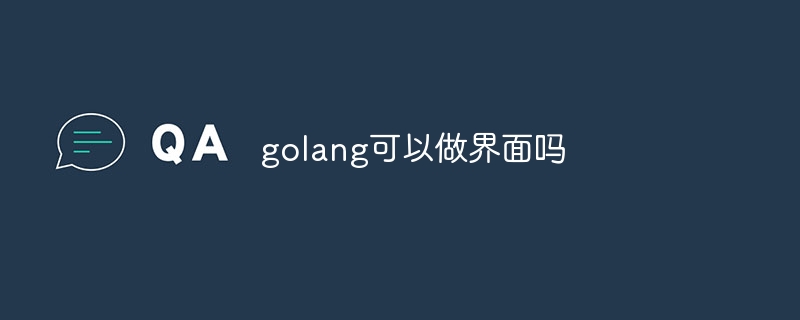
Golang can be used as an interface. It is a programming language that can be used to develop user interfaces. Although its native interface package may not be as powerful and diverse as graphical interface frameworks in other languages, it is suitable for simple applications. It is enough. For more complex user interfaces, developers can choose to use third-party interface libraries to meet their needs. Whether using native interface packages or third-party interface libraries, golang can provide efficient performance and concurrency, making interface development easier and more reliable.

The operating environment of this article: Windows 10 system, go1.20 version, DELL G3 computer.
Golang is a programming language developed by Google. It has received widespread attention for its efficient performance and concurrency. Although Golang is mainly used for server-side programming and system-level programming, it can also be used to develop user interfaces.
In traditional software development, user interfaces are typically built using technologies such as JavaScript, HTML, and CSS. However, Golang provides a package for building user interfaces, namely Golang's native interface package "package ui". Although this package is not part of the official standard library, it is developed and maintained by the Golang community and can be used to create Golang-based graphical user interfaces (GUIs).
Golang’s native interface package is based on the graphics library of the operating system, so developers can directly use it to create interface elements such as windows, buttons, and text boxes, and interact with users. Although this package is not as feature-rich as graphical interface packages for other languages, it is sufficient for simple applications.
Compared with graphical interface frameworks in other languages, Golang’s native interface package has the following advantages:
1. Cross-platform support: Golang’s native interface package supports cross-platform Multiple operating systems including Windows, MacOS and Linux. This means developers can use the same code to build user interfaces for different operating systems.
2. Simple and easy to use: Golang’s native interface package provides a set of simple and easy-to-use interfaces and classes. Developers can easily create interface elements such as windows, buttons, and text boxes. , and add event processing logic on it.
Although Golang's native interface package provides basic interface elements and interactive functions, for complex user interfaces, it may not be enough to meet the needs. In this case, developers can choose to use third-party interface libraries, such as fyne, qt, and electron. These libraries provide richer interface elements and interactive functions, and support more operating systems.
To sum up, Golang is a programming language that can be used to develop user interfaces. Although its native interface package may not be as powerful and diverse as graphical interface frameworks in other languages, it is enough for simple applications. For more complex user interfaces, developers can choose to use third-party interface libraries to meet their needs. Whether using native interface packages or third-party interface libraries, Golang can provide efficient performance and concurrency, making interface development easier and more reliable.
The above is the detailed content of Can golang be used as an interface?. For more information, please follow other related articles on the PHP Chinese website!
 How to define variables in golang
How to define variables in golang
 What are the data conversion methods in golang?
What are the data conversion methods in golang?
 What are the commonly used libraries in golang?
What are the commonly used libraries in golang?
 What is the difference between golang and python
What is the difference between golang and python
 what is index
what is index
 Introduction to hard disk performance indicators
Introduction to hard disk performance indicators
 Top ten currency trading software apps ranking list
Top ten currency trading software apps ranking list
 What is pr
What is pr
 U coin price today
U coin price today